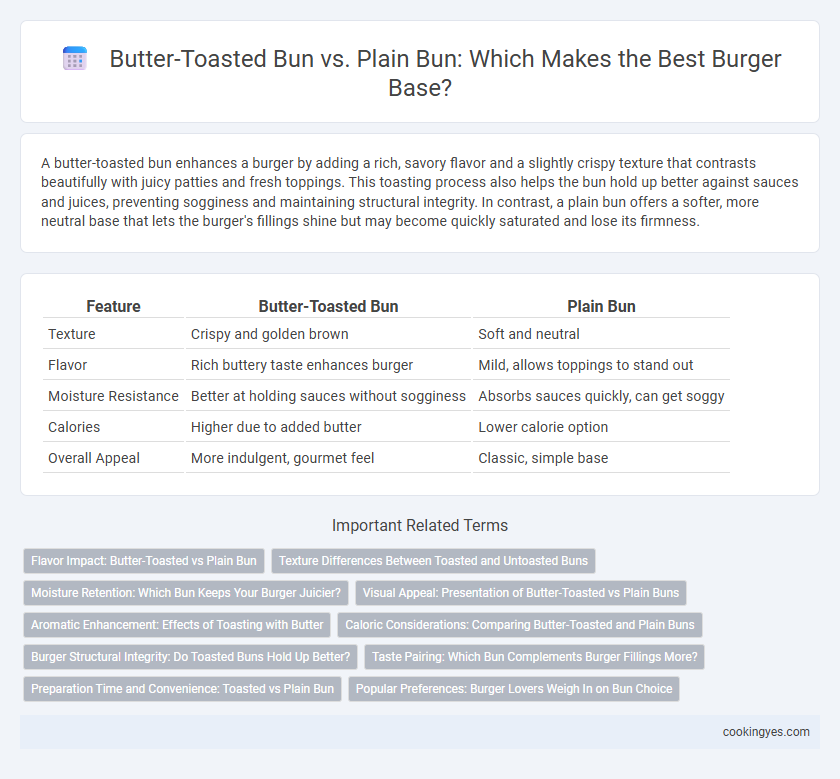A butter-toasted bun enhances a burger by adding a rich, savory flavor and a slightly crispy texture that contrasts beautifully with juicy patties and fresh toppings. This toasting process also helps the bun hold up better against sauces and juices, preventing sogginess and maintaining structural integrity. In contrast, a plain bun offers a softer, more neutral base that lets the burger's fillings shine but may become quickly saturated and lose its firmness.
Table of Comparison
| Feature | Butter-Toasted Bun | Plain Bun |
|---|---|---|
| Texture | Crispy and golden brown | Soft and neutral |
| Flavor | Rich buttery taste enhances burger | Mild, allows toppings to stand out |
| Moisture Resistance | Better at holding sauces without sogginess | Absorbs sauces quickly, can get soggy |
| Calories | Higher due to added butter | Lower calorie option |
| Overall Appeal | More indulgent, gourmet feel | Classic, simple base |
Flavor Impact: Butter-Toasted vs Plain Bun
Butter-toasted buns elevate burger flavor by adding a rich, savory depth through caramelized butter notes, enhancing the overall taste profile and mouthfeel. Plain buns provide a neutral base, allowing the burger's meat and toppings to shine without interference but often lack the complexity and warmth delivered by toasted butter. The choice between butter-toasted and plain buns significantly influences texture contrast and flavor harmony in the burger experience.
Texture Differences Between Toasted and Untoasted Buns
Butter-toasted buns offer a crispy, golden exterior that enhances the burger's overall texture by providing a slight crunch, contrasting with the soft, tender crumb inside. Plain buns retain a uniform softness throughout, resulting in a more delicate bite that allows the burger's fillings to stand out without added texture complexity. The toasted surface also helps prevent sogginess from juices and sauces, maintaining structural integrity during eating.
Moisture Retention: Which Bun Keeps Your Burger Juicier?
Butter-toasted buns enhance moisture retention by creating a slightly crisp barrier that prevents burger juices from soaking into the bread, preserving the patty's juiciness longer compared to plain buns. The fat from the butter also adds richness, helping to lock in moisture and improve overall texture. Plain buns tend to absorb more grease and juices, which can lead to a soggy base and a less juicy burger experience.
Visual Appeal: Presentation of Butter-Toasted vs Plain Buns
Butter-toasted buns exhibit a golden-brown, slightly glossy surface that creates a visually appetizing contrast with the burger ingredients, enhancing overall presentation. The toasting process adds subtle texture highlights, making the bun appear crisp yet soft, which draws attention and elevates the aesthetic appeal of the burger. In contrast, plain buns often lack this depth of color and texture, resulting in a more muted, less visually striking base.
Aromatic Enhancement: Effects of Toasting with Butter
Butter-toasted buns significantly enhance aromatic compounds in burgers, releasing rich, nutty, and caramelized notes that plain buns lack. The Maillard reaction triggered during toasting with butter intensifies flavor profiles, creating a more appetizing sensory experience. This aromatic enhancement not only complements the savory fillings but also improves overall burger appeal and satisfaction.
Caloric Considerations: Comparing Butter-Toasted and Plain Buns
Butter-toasted buns typically contain higher calories than plain buns due to the added fat from butter, contributing an extra 50 to 70 calories per bun. Plain buns generally have fewer calories, averaging around 120 to 150 calories each, making them a lower-calorie option for burger bases. Choosing between butter-toasted and plain buns impacts the overall caloric content of the burger, influencing dietary and nutritional decisions.
Burger Structural Integrity: Do Toasted Buns Hold Up Better?
Butter-toasted buns offer enhanced structural integrity compared to plain buns by providing a slightly crispy, golden layer that resists sogginess from burger juices and condiments. This toasted barrier helps maintain the bun's shape and prevents it from becoming overly saturated, which is a common issue with plain buns during prolonged eating. Consequently, butter-toasted buns improve the overall eating experience by holding the burger ingredients together more effectively and reducing mess.
Taste Pairing: Which Bun Complements Burger Fillings More?
Butter-toasted buns offer a rich, savory flavor and a slightly crispy texture that enhances the taste of juicy burger patties, melted cheese, and caramelized onions. Plain buns provide a neutral base that allows the bold flavors of spicy sauces, pickles, and fresh vegetables to stand out without overpowering them. Choosing between butter-toasted and plain buns depends on whether the burger fillings benefit from added richness and crunch or require a simpler, more subtle bread foundation.
Preparation Time and Convenience: Toasted vs Plain Bun
Butter-toasted buns require extra preparation time as they need to be spread with butter and toasted until golden, adding a crispy texture that enhances the burger experience. Plain buns save time by eliminating the toasting step, making them more convenient for quick assembly and fast service. For busy kitchens, plain buns streamline operations, while butter-toasted buns offer a flavor and texture boost worth the added effort in premium or gourmet burger settings.
Popular Preferences: Burger Lovers Weigh In on Bun Choice
Butter-toasted buns enhance burgers with a rich, crispy texture that complements juicy patties, making them a favorite among many burger enthusiasts. Plain buns offer a soft, neutral base that highlights the toppings and meat without added flavors, appealing to purists who prefer simplicity. Popular preference often depends on individual taste, with butter-toasted buns favored in gourmet and specialty burger scenes, while plain buns remain a classic choice in traditional burger joints.
Butter-toasted bun vs Plain bun for burger base Infographic

 cookingyes.com
cookingyes.com